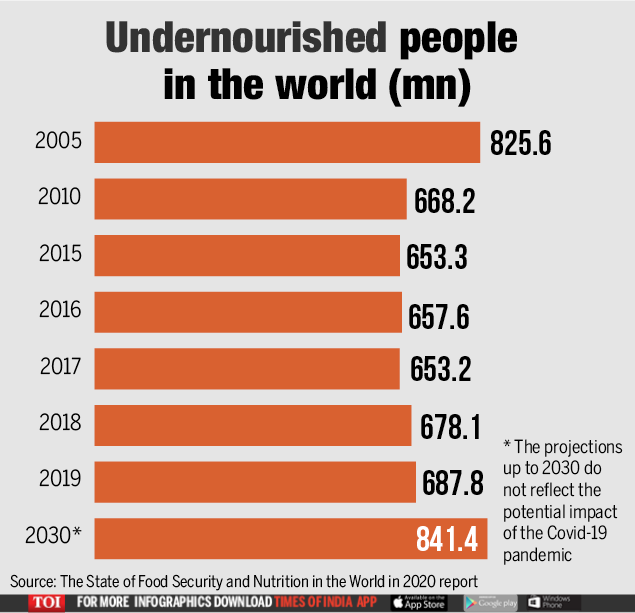
NEW DELHI: The world is not on track to achieve the target of Zero Hunger by 2030. According to a UN report titled The State of Food Security and Nutrition in the World in 2020, there were almost 690 million undernourished people globally in 2019. This is an increase of 10 million undernourished people from 2018, and by 60 million in the last five years.
According to the report, the current coronavirus pandemic is likely to accelerate the projected increase in the number of hungry people. The pandemic may push 83- 132 million more people to the total number of undernourished in the world in 2020. By 2030, over 840 million people could be affected by hunger.

There are a number of underlying causes of increase in undernourishment, including weak, stagnant or deteriorating economic conditions, the report states. Economic slowdowns and downturns, particularly since the financial crisis of 2008–2009, have had significant impacts on hunger through various channels.
There are also other factors involved such as increasing frequency of extreme weather events, altered environmental conditions, and the associated spread of pests and diseases over the last 15 years.
Problem of malnutrition in children
The report highlights progress made towards meeting global nutrition targets, but warns that world is off track to achieve these targets, including those on child stunting, wasting and being overweight. In 2019, a staggering 2 billion people did not have regular access to nutritious and sufficient food.
The burden of child malnutrition remains a threat around the world. Globally, 21.3 percent (144 million) children are stunted, 6.9 percent (47 million) are affected by wasting and 5.6 percent (38.3 million) were overweight, while at least 340 million children suffered from micronutrient deficiencies.

Indian scenario
Back home, there is some good news. The number of undernourished people in the country is down by 60 million. In percentage terms, the prevalence of undernourishment in the total population in the country has declined from 21.7 per cent in 2004-06 to 14 per cent in 2017-19.
There has also been some progress in meeting nutritional targets. Stunting in children under 5 years of age has reduced from 47.8 per cent in 2012 to 34.7 per cent in 2019. Also, more infants are breastfed now than before.
However, the country has more anaemic women and obese people. The number of women of reproductive age (15–49) affected by anaemia grew to 175.6 million in 2016 from 165.6 million in 2012. Similarly, the number of obese adults (18 years and older) grew to 34.3 millions in 2016 from 25.2 million in 2012.
According to the report, the current coronavirus pandemic is likely to accelerate the projected increase in the number of hungry people. The pandemic may push 83- 132 million more people to the total number of undernourished in the world in 2020. By 2030, over 840 million people could be affected by hunger.

There are a number of underlying causes of increase in undernourishment, including weak, stagnant or deteriorating economic conditions, the report states. Economic slowdowns and downturns, particularly since the financial crisis of 2008–2009, have had significant impacts on hunger through various channels.
There are also other factors involved such as increasing frequency of extreme weather events, altered environmental conditions, and the associated spread of pests and diseases over the last 15 years.
Problem of malnutrition in children
The report highlights progress made towards meeting global nutrition targets, but warns that world is off track to achieve these targets, including those on child stunting, wasting and being overweight. In 2019, a staggering 2 billion people did not have regular access to nutritious and sufficient food.
The burden of child malnutrition remains a threat around the world. Globally, 21.3 percent (144 million) children are stunted, 6.9 percent (47 million) are affected by wasting and 5.6 percent (38.3 million) were overweight, while at least 340 million children suffered from micronutrient deficiencies.

Indian scenario
Back home, there is some good news. The number of undernourished people in the country is down by 60 million. In percentage terms, the prevalence of undernourishment in the total population in the country has declined from 21.7 per cent in 2004-06 to 14 per cent in 2017-19.
There has also been some progress in meeting nutritional targets. Stunting in children under 5 years of age has reduced from 47.8 per cent in 2012 to 34.7 per cent in 2019. Also, more infants are breastfed now than before.
However, the country has more anaemic women and obese people. The number of women of reproductive age (15–49) affected by anaemia grew to 175.6 million in 2016 from 165.6 million in 2012. Similarly, the number of obese adults (18 years and older) grew to 34.3 millions in 2016 from 25.2 million in 2012.
Download
The Times of India News App for Latest World News

Coronavirus outbreak
Trending Topics
LATEST VIDEOS
More from TOI
Navbharat Times
Featured Today in Travel
Get the app









